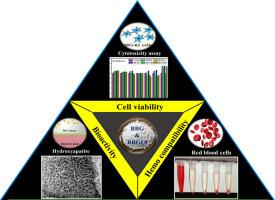Tailoring structure and bioactivity of sol-gel derived borate glasses and glass-ceramics through calcination for tissue engineering
IF 5.4
3区 化学
Q1 CHEMISTRY, INORGANIC & NUCLEAR
引用次数: 0
Abstract
Borate bioactive glasses (BBGs) and glass ceramics are emerging biomaterials with enormous applications in repairing damaged tissues, owing to their controlled degradation, antimicrobial properties, and ability to promote tissue regeneration. In this work, BBG with composition B2O3-CaO-Li2O-P2O5 was produced using the sol-gel technique and subsequently calcinated at temperatures of 600, 650, 700, 750, and 800 °C. A range of characterization techniques was employed to assess the impact of calcination temperature on the structural and biological responses of the glasses. BET analysis confirmed their mesoporous texture and observed the change in pore diameter with calcination temperatures, which is perfect for prolonged ion release and cell contact. Further, the structural modification with temperature and in vitro bioactivity, evidenced by hydroxyapatite (HAp) deposition on the material's surface, was verified by XRD, FTIR, and FESEM analysis. A dense and enhanced HAp layer was deposited with an immersion period in SBF, and it predominantly covers the crystalline phases CaB2O4, Li₂B₄O₇, and Ca₃(PO₄)₂ at 750 and 800 °C. This ability validated the glasses bioactivity and demonstrated their capacity to promote tissue regeneration. Moreover, the hemocompatibility experiments revealed that all BBGs were biocompatible, with no hemolytic effects and a lysis rate of below 5 %. The cell viability assays by culturing the cells with MG-63 osteoblast cells demonstrated superior cytocompatibility, non-toxic behavior, and increased cell proliferation. Over all these results demonstrate the promise of BBGs as useful materials for applications involving soft and hard tissue engineering.

组织工程用溶胶-凝胶衍生硼酸盐玻璃和玻璃陶瓷的煅烧裁剪结构和生物活性
硼酸盐生物活性玻璃(bbg)和玻璃陶瓷是新兴的生物材料,由于其可控制降解、抗菌性能和促进组织再生的能力,在修复损伤组织方面有着巨大的应用。本研究采用溶胶-凝胶法制备了b2o3 - cao - li20 - p2o5组成的BBG,并分别在600、650、700、750和800℃的温度下进行了煅烧。采用了一系列表征技术来评估煅烧温度对玻璃结构和生物反应的影响。BET分析证实了它们的介孔结构,并观察到孔径随煅烧温度的变化,这对于延长离子释放和细胞接触是完美的。此外,通过XRD, FTIR和FESEM分析,羟基磷灰石(HAp)沉积在材料表面,证实了温度和体外生物活性的结构修饰。在750°C和800°C的SBF中,沉积了致密的强化HAp层,主要覆盖了CaB2O4、Li₂B₄O₇和Ca₃(PO₄)₂晶相。这种能力证实了玻璃的生物活性,并证明了它们促进组织再生的能力。此外,血液相容性实验显示,所有血脑屏障均具有生物相容性,无溶血作用,溶解率低于5%。MG-63成骨细胞培养的细胞活力实验表明,MG-63成骨细胞具有良好的细胞相容性、无毒行为和细胞增殖能力。总的来说,这些结果表明了bbg作为软硬组织工程应用的有用材料的前景。
本文章由计算机程序翻译,如有差异,请以英文原文为准。
求助全文
约1分钟内获得全文
求助全文
来源期刊

Inorganic Chemistry Communications
化学-无机化学与核化学
CiteScore
5.50
自引率
7.90%
发文量
1013
审稿时长
53 days
期刊介绍:
Launched in January 1998, Inorganic Chemistry Communications is an international journal dedicated to the rapid publication of short communications in the major areas of inorganic, organometallic and supramolecular chemistry. Topics include synthetic and reaction chemistry, kinetics and mechanisms of reactions, bioinorganic chemistry, photochemistry and the use of metal and organometallic compounds in stoichiometric and catalytic synthesis or organic compounds.
 求助内容:
求助内容: 应助结果提醒方式:
应助结果提醒方式:


